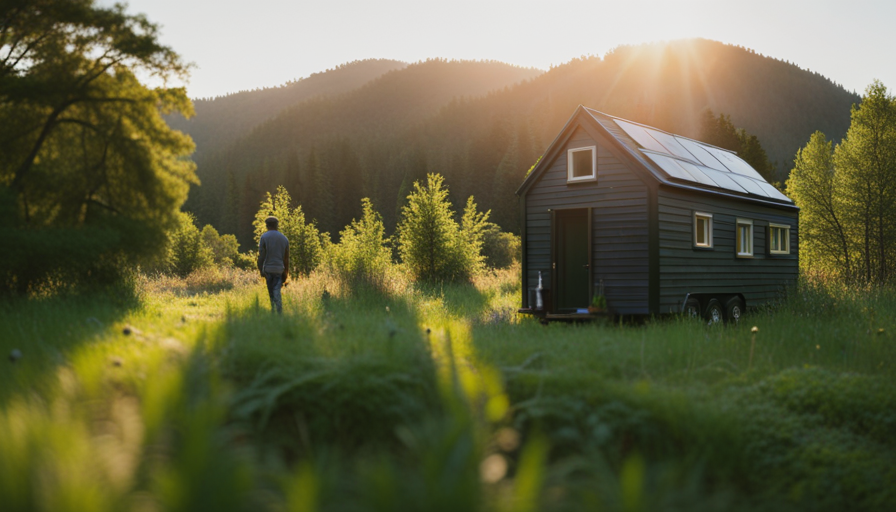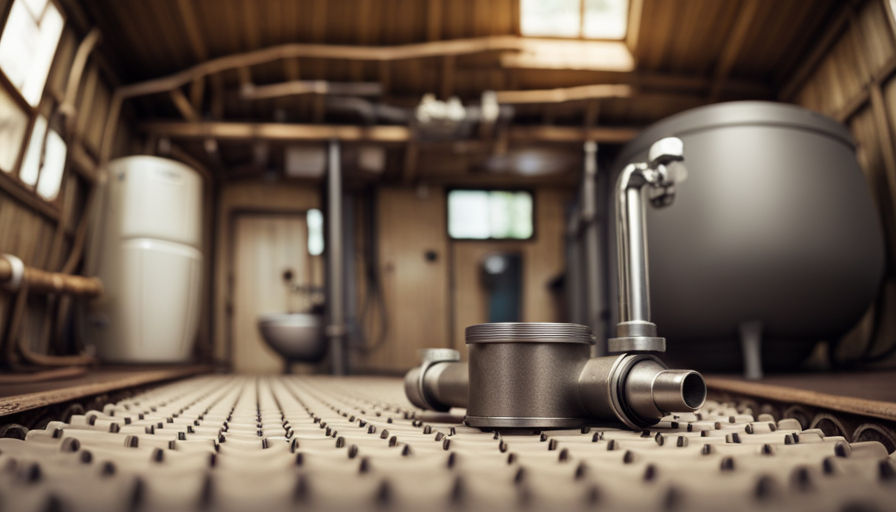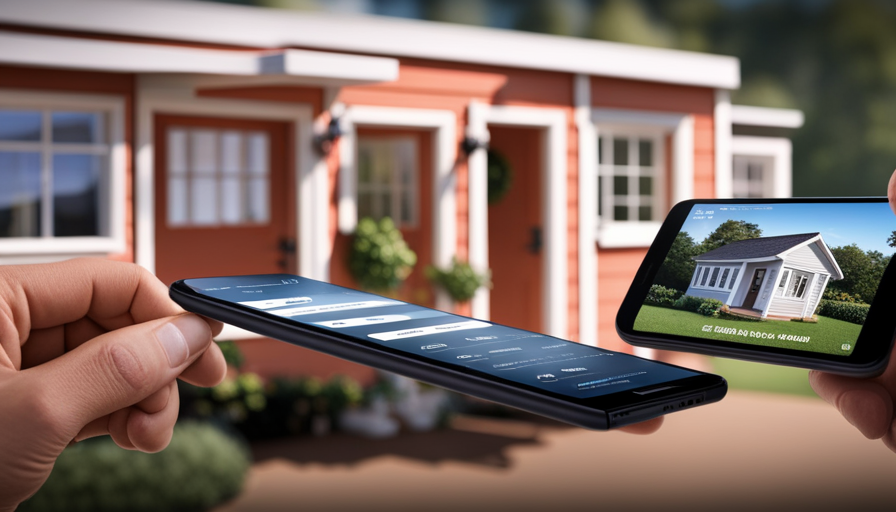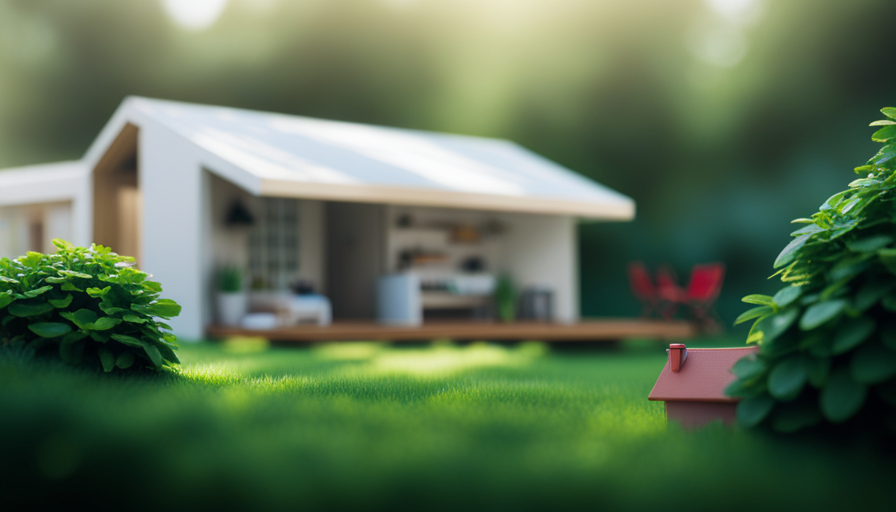In the midst of our consumer-driven society, a quiet revolution is taking place. The tiny house movement, focusing on simplifying and downsizing living spaces, is attracting individuals looking for a more meaningful and independent life. Drawing inspiration from 19th-century transcendentalist beliefs, this movement promotes self-reliance, minimalism, and a deep connection to nature.
By embracing minimalism and self-sufficiency, tiny house dwellers are challenging societal norms and redefining the meaning of success. Through detachment from materialism and a focus on living with less, they find fulfillment and meaning in the simplicity of their surroundings. Furthermore, this movement is inspiring others to question their own lives and consider alternative ways of living.
In this article, we will explore how the tiny house movement reflects the transcendentalism value of self-reliance and the power it holds in transforming our lives.
Key Takeaways
- The tiny house movement reflects the transcendentalism value of self-reliance by embracing principles of simplicity, self-sufficiency, and connection with nature.
- Living in a tiny house promotes financial freedom, reduced environmental impact, and a simpler lifestyle, aligning with the values of self-reliance and minimalistic living.
- Sustainable practices in tiny houses, such as lower energy consumption, use of renewable energy sources, and rainwater collection, further exemplify the value of self-reliance and a focus on responsible, eco-friendly living.
- The power of community in the tiny house movement is evident through the strong sense of connection among like-minded individuals, who share resources, ideas, and support, promoting not only practical benefits but also financial independence and a sense of belonging.
Transcendentalism and its Principles
Now, let’s dive into transcendentalism and its principles, so you can fully appreciate how the tiny house movement reflects the value of self-reliance.
Transcendentalism, a philosophical and spiritual movement that emerged in the 19th century, emphasized the importance of individual intuition and direct experience with nature. Its proponents believed in the inherent goodness of both people and nature, and sought to live in harmony with the natural world.
One of the central principles of transcendentalism is self-reliance, which encourages individuals to rely on their own instincts and abilities rather than conforming to societal norms and expectations. In modern society, self-reliance has become increasingly important as people strive to break free from the constraints of consumerism and find fulfillment in simplicity.
The tiny house movement, with its focus on minimalistic living and sustainable practices, embodies this spirit of self-reliance. By choosing to live in tiny houses, individuals are making a conscious decision to downsize their possessions and live more simply. They are taking control of their own lives, reducing their dependence on material possessions and societal pressures. In doing so, they are embracing the principles of self-reliance and finding freedom and fulfillment in living with less.
This transition into the subsequent section about the tiny house movement highlights how the principles of transcendentalism can be seen in this modern lifestyle choice.
The Tiny House Movement
Surprisingly, the trend of living in compact homes has become a popular lifestyle choice among many, showcasing a strong sense of independence and resourcefulness. The tiny house movement, as it’s commonly known, embraces the principles of self-reliance and minimalism, aligning closely with the values of transcendentalism.
-
Financial independence: By opting for a smaller living space, individuals can significantly reduce their expenses. Tiny homes are more affordable to build, maintain, and operate than traditional houses. This financial freedom allows individuals to focus on their personal growth and pursue their passions.
-
Simplified living: Tiny houses encourage a minimalist lifestyle, promoting the idea of owning fewer possessions and valuing experiences over material possessions. With limited space, individuals are forced to declutter and prioritize their belongings, leading to a more intentional and fulfilling life.
-
Environmental consciousness: The tiny house movement emphasizes sustainable living by using eco-friendly materials and energy-efficient systems. These homes have a smaller ecological footprint, reducing waste and energy consumption. Individuals in tiny houses often adopt alternative energy sources such as solar panels, further reducing their impact on the environment.
-
Self-sufficiency: Living in a tiny house encourages individuals to be more self-reliant. With limited space and resources, tiny house owners must learn to be creative problem solvers and find innovative ways to meet their needs. From growing their own food to using composting toilets, tiny house dwellers embrace self-sufficiency as a way of life.
Transitioning into the subsequent section about ‘minimalism and self-sufficiency,’ the tiny house movement embodies these values and serves as a practical example of how individuals can live a fulfilling and sustainable life with fewer material possessions.
Minimalism and Self-Sufficiency
Embrace the principles of minimalism and self-sufficiency as you simplify your life and reduce your reliance on material possessions. The tiny house movement is not just about downsizing your living space; it is a lifestyle choice that promotes self-sufficiency and financial independence. By living in a tiny house, individuals can significantly reduce their expenses and debt, allowing them to break free from the cycle of working long hours to pay off mortgages and loans.
Living in a tiny house requires adopting a minimalist lifestyle, which focuses on owning only what is necessary and letting go of unnecessary clutter. This shift towards simplicity not only helps individuals save money but also promotes mental well-being. Studies have shown that living with fewer material possessions can lead to reduced stress and increased happiness.
To illustrate the concept of living with less, here is a comparison between a traditional home and a tiny house:
| Traditional Home | Tiny House |
|---|---|
| Large mortgage payments | Affordable or no mortgage |
| High utility bills | Lower energy consumption |
| Maintenance and cleaning | Minimal upkeep |
| Excess space | Efficient use of space |
| Accumulation of belongings | Streamlined possessions |
Transitioning into a life of minimalism and self-sufficiency allows individuals to break free from the burden of excessive material possessions and focus on what truly matters.
Living with Less
Living in a tiny house offers numerous benefits, including financial freedom, reduced environmental impact, and a simpler, more intentional lifestyle. By embracing minimalism and living with less, individuals are able to rely on themselves for their basic needs and find contentment in the essentials.
This promotes self-reliance by challenging societal norms of excessive consumption and encouraging individuals to prioritize what truly matters in life.
Benefits of Living in a Tiny House
Imagine the freedom and independence you’ll feel when you live in a tiny house, reaping the benefits of a minimalist lifestyle. Living in a tiny house offers numerous advantages, including cost-effective living and increased mobility. By embracing a smaller living space, you can significantly reduce your expenses. Tiny houses are more affordable to build, maintain, and heat, allowing you to save money and live a more frugal life. Additionally, tiny houses are usually built on wheels, enabling you to easily relocate and explore different areas without being tied down to a specific location. This increased mobility allows for new experiences and a sense of adventure. Transitioning to a minimalist lifestyle in a tiny house not only promotes self-reliance but also encourages a deeper connection with nature and a greater appreciation for the simple things in life.
How Minimalism Promotes Self-Reliance
Transitioning to a minimalist lifestyle in a tiny house opens the door to a world where self-reliance blossoms like a vibrant garden in spring. By embracing a minimalist lifestyle, individuals are encouraged to prioritize their needs over their wants, which fosters a self-sufficiency mindset.
Living in a tiny house requires one to carefully consider their possessions and make conscious choices about what is truly necessary. This promotes self-reliance as individuals learn to rely on their own skills and resourcefulness to meet their needs. From building furniture from reclaimed materials to growing their own food, tiny house dwellers develop a sense of independence and self-sustainability.
This minimalist lifestyle encourages individuals to rely on themselves rather than external factors for their well-being. Transitioning to a minimalist lifestyle in a tiny house sets the stage for the subsequent section about detachment from materialism, as individuals learn to find contentment in simplicity and prioritize experiences over possessions.
Detachment from Materialism
By embracing simplicity and letting go of the desire for material possessions, you can truly experience the freedom and fulfillment that comes with detachment from materialism in the tiny house movement. Here are four ways in which the tiny house movement promotes detachment from materialism:
-
Downsizing: Living in a tiny house requires you to downsize and let go of unnecessary belongings. This process forces you to prioritize what truly matters and detach from the idea that material possessions define your worth.
-
Minimalistic living: Tiny houses are designed to provide the essentials and eliminate excess. By living a minimalist lifestyle, you can break free from the constant need for material possessions and focus on what brings you true happiness and fulfillment.
-
Financial freedom: With a smaller living space, tiny house owners often have lower expenses and reduced debt. This financial freedom allows them to detach from the consumerist mindset and prioritize experiences and personal growth over material possessions.
-
Environmental consciousness: The tiny house movement encourages sustainable living practices, such as using renewable energy sources and minimizing waste. By embracing a more eco-friendly lifestyle, you detach from the harmful cycle of materialism and contribute to a healthier planet.
By detaching from materialism and embracing simplicity, the tiny house movement paves the way for sustainable living practices that will be discussed in the subsequent section.
Sustainable Living
When it comes to sustainable living, tiny houses offer a number of environmental benefits. First and foremost, their small size means they require less energy to heat and cool, resulting in lower carbon emissions.
Additionally, many tiny house owners opt for off-grid solutions such as solar panels and rainwater collection, further reducing their ecological footprint.
Finally, the self-reliant nature of living in a tiny house encourages individuals to be mindful of their consumption, leading to less waste and a more sustainable lifestyle overall.
Environmental Benefits of Tiny Houses
Imagine living in a tiny house, where you can reduce your carbon footprint and embrace nature’s harmony while enjoying the comforts of a cozy home. Tiny houses have gained popularity due to their environmental benefits and energy efficiency. Here are three ways tiny houses contribute to a greener lifestyle:
-
Reduced Environmental Impact: Tiny houses require fewer resources to build and maintain compared to traditional houses. They use less energy for heating and cooling, resulting in lower greenhouse gas emissions. Additionally, their small size allows for minimal land disturbance during construction.
-
Energy Efficiency: Tiny houses are designed with energy efficiency in mind. They’re equipped with energy-saving appliances, LED lighting, and efficient insulation. With their smaller square footage, it takes less energy to power and heat the entire space, leading to lower energy consumption.
-
Sustainable Living: Living in a tiny house promotes a more sustainable lifestyle. It encourages minimalism, reducing the need for excessive consumption and waste. Furthermore, many tiny house dwellers opt for off-grid or renewable energy sources, such as solar panels, further reducing their ecological footprint.
By embracing the tiny house movement, individuals can significantly reduce their ecological footprint through self-reliance, fostering a more sustainable and harmonious relationship with the environment.
Reducing Ecological Footprint through Self-Reliance
Living in a tiny house allows for a more self-reliant lifestyle, fostering a deeper connection with the environment and reducing one’s ecological footprint. By embracing self-reliance, tiny house dwellers have the opportunity to significantly reduce waste and live more sustainably.
With limited space, they are forced to be mindful of their consumption habits and prioritize what is truly necessary. This often leads to a simpler, more minimalist lifestyle, where people learn to appreciate the value of experiences over material possessions.
Additionally, self-reliance encourages individuals to explore alternative lifestyles, such as growing their own food, composting, and using renewable energy sources. These practices not only reduce their impact on the environment but also promote a sense of personal fulfillment and empowerment.
By reducing waste and embracing alternative lifestyles, tiny house dwellers can truly embrace nature and live harmoniously with the environment.
Embracing Nature
Embrace the beauty of nature in a tiny house, where you can wake up to the sound of birds chirping and the gentle rustling of leaves. The tiny house movement encourages a deep connection with nature and promotes harmony with the environment.
By living in a small, sustainable space, individuals have the opportunity to be more in tune with their surroundings and appreciate the natural world.
Tiny houses are often designed with large windows and open floor plans to maximize natural light and provide expansive views of the outdoors. This allows residents to feel immersed in nature even when they are indoors. Additionally, many tiny homes are built with eco-friendly materials and incorporate sustainable practices such as rainwater collection and solar power, further aligning with the principles of self-reliance and environmental consciousness.
Living in a tiny house encourages individuals to spend more time outdoors, engaging in activities like gardening, hiking, and enjoying the surrounding landscapes. The small size of the house also encourages a simpler lifestyle, with fewer material possessions and a focus on experiences rather than material wealth.
Finding fulfillment and meaning in life is a natural extension of embracing nature in a tiny house. By simplifying our lives and connecting with the natural world, we can cultivate a sense of purpose and contentment.
Finding Fulfillment and Meaning
After embracing nature and experiencing the profound connection it brings, another significant aspect of the tiny house movement is finding fulfillment and meaning.
Living in a tiny house allows individuals to simplify their lives and focus on what truly matters, leading them to discover their purpose and experience personal growth.
By letting go of unnecessary material possessions and living in a smaller space, people are forced to prioritize and reevaluate their values. This process often leads to a deeper understanding of oneself and what brings true happiness.
With fewer distractions and a more intentional lifestyle, individuals have the opportunity to explore their passions, pursue meaningful relationships, and engage in activities that align with their values.
The tiny house movement encourages people to step away from the consumerist mindset and instead focus on personal development and self-improvement. Many tiny house dwellers find that by living with less, they gain a greater sense of fulfillment and contentment. This shift in mindset allows them to focus on personal growth, self-reliance, and finding purpose in their lives.
As tiny house enthusiasts discover the transformative power of simplifying and finding fulfillment, they often become inspired to share their experiences with others, sparking a desire to inspire and empower others to embark on their own journey towards a more meaningful and purposeful life.
Inspiring Others
The tiny house movement has inspired me to spread the message of self-reliance to others.nnThrough my own experience living in a tiny house, I’ve realized the value of being self-sufficient and reducing my reliance on material possessions.nnI believe that by encouraging others to embrace a more minimalist and meaningful existence, we can create positive change in our society.
Spreading the Message of Self-Reliance
By spreading the message of self-reliance, the tiny house movement empowers individuals to take control of their lives and embrace a simpler, more sustainable way of living.
This movement has been instrumental in spreading awareness about the benefits of a self-sustaining lifestyle. Through various platforms such as social media, documentaries, and community events, the tiny house movement has successfully reached a wide audience and inspired many to consider alternative housing options.
By showcasing how individuals can live comfortably with less and reduce their dependence on external resources, the movement encourages a shift towards a more meaningful existence. It challenges the societal norms of consumerism and promotes self-sufficiency, creativity, and a deeper connection with nature.
The tiny house movement serves as a catalyst for change, motivating people to reevaluate their priorities and embrace a lifestyle that values simplicity, self-reliance, and sustainability.
Encouraging a Shift Towards a More Meaningful Existence
After spreading the message of self-reliance, the tiny house movement has not only inspired people to embrace a simpler lifestyle but has also encouraged a shift in priorities towards a more meaningful existence.
With the limited space in tiny houses, individuals are forced to reevaluate their possessions and focus on what truly matters to them. This intentional living allows people to prioritize experiences over material possessions, fostering a deeper sense of fulfillment and connection to the world around them.
By choosing to live in a tiny house, individuals are making a conscious decision to reject the societal norms of consumerism and instead focus on self-reliance and personal growth. This shift in priorities aligns perfectly with the transcendentalist value of self-reliance, as it empowers individuals to take control of their own lives and find true satisfaction in the pursuit of a simpler, more intentional existence.
Transitioning to the subsequent section, the power of the tiny house movement lies in its ability to inspire change on a larger scale.
Conclusion: The Power of the Tiny House Movement
In conclusion, the power of the tiny house movement lies in its ability to embody the transcendental value of self-reliance. By encouraging individuals to downsize their living spaces and simplify their lives, the movement promotes a sense of independence and self-sufficiency.
One of the key aspects of the tiny house movement is the power of community. While living in a tiny house may seem isolating, it actually fosters a strong sense of connection among like-minded individuals. Tiny house communities have sprung up all over the country, where individuals can come together to share resources, ideas, and support. This power of community not only provides a sense of belonging but also offers practical benefits such as shared maintenance tasks and cost-sharing for utilities.
Financial independence is another crucial aspect of the tiny house movement. By reducing living expenses through downsizing, individuals can free themselves from the burden of excessive debt and high housing costs. This newfound financial freedom allows them to pursue their passions, travel, or focus on meaningful experiences instead of being tied down by mortgage payments or rent.
The tiny house movement empowers individuals to live a more self-reliant lifestyle by promoting the power of community and financial independence. Through these principles, individuals can find a greater sense of fulfillment, freedom, and connection with themselves and the world around them.
Frequently Asked Questions
How can the principles of transcendentalism be applied to everyday life?
Applying Transcendentalism principles in modern society is crucial for finding inner peace in a fast-paced world. By embracing self-reliance, individuals can break free from societal expectations and connect with their true selves.
This involves relying on one’s own judgment, seeking solitude in nature, and trusting in intuition. By practicing self-reliance, we can cultivate a sense of independence and authenticity, ultimately leading to a more fulfilling and meaningful life.
What are the benefits of living in a tiny house?
Living in a tiny house offers numerous benefits. Firstly, it’s a cost-effective living option as it requires less money to build, maintain, and heat or cool.
Additionally, tiny houses promote environmental sustainability by minimizing energy consumption and reducing waste. They also encourage a simpler lifestyle, allowing individuals to focus on what truly matters.
Overall, living in a tiny house can provide financial freedom, reduce environmental impact, and promote a more intentional and fulfilling life.
How does minimalism contribute to self-sufficiency?
Living a minimalist lifestyle promotes self-sufficiency by emphasizing the importance of only having what we truly need. It encourages us to prioritize our needs over our wants, reducing our reliance on material possessions.
By embracing a minimalist mindset, we can focus on the essentials and eliminate excess, allowing us to be more self-reliant. This lifestyle values simplicity, self-discipline, and resourcefulness, empowering individuals to rely on themselves and live a more self-sufficient life.
What are some practical tips for living with less in a tiny house?
Practical organization is key to living with less in a tiny house. Maximizing space is essential for a comfortable and functional living environment. Some practical tips for achieving this include utilizing vertical storage solutions, such as shelves or hanging racks, using multi-functional furniture, like a sofa that can convert into a bed, and implementing clever storage solutions, such as under-bed storage or built-in cabinets.
These strategies help create a well-organized and clutter-free living space in a tiny house.
How can embracing nature enhance one’s sense of fulfillment and meaning in life?
Embracing nature can have a profound impact on our mental health and overall sense of fulfillment. It allows us to reconnect with the natural world, providing a sense of peace and serenity.
Additionally, embracing nature encourages minimalism, as we realize that we don’t need material possessions to find meaning in life. This relationship between minimalism and sustainability is crucial in creating a more environmentally conscious lifestyle.
By living in harmony with nature, we find a deeper sense of purpose and fulfillment.
Conclusion
In conclusion, the Tiny House Movement reflects the transcendentalism value of self-reliance in numerous ways. By embracing minimalism and self-sufficiency, individuals living in tiny homes demonstrate their ability to thrive with less.
They detach from materialism and prioritize experiences over possessions, finding fulfillment and meaning in simplicity. One inspiring example is Sarah, who downsized to a tiny house and found freedom from financial burdens. With reduced expenses and a stronger connection to nature, she now leads a more fulfilling and sustainable lifestyle.
The Tiny House Movement empowers individuals to live authentically and inspire others to do the same.
Hi, I’m Emma. I’m the Editor in Chief of Tiny House 43, a blog all about tiny houses. While tree houses are often associated with childhood, they can be the perfect adult retreat. They offer a cozy space to relax and unwind, surrounded by nature. And since they’re typically built on stilts or raised platforms, they offer stunning views that traditional homes simply can’t match. If you’re looking for a unique and romantic getaway, a tree house tiny house might just be the perfect option.










